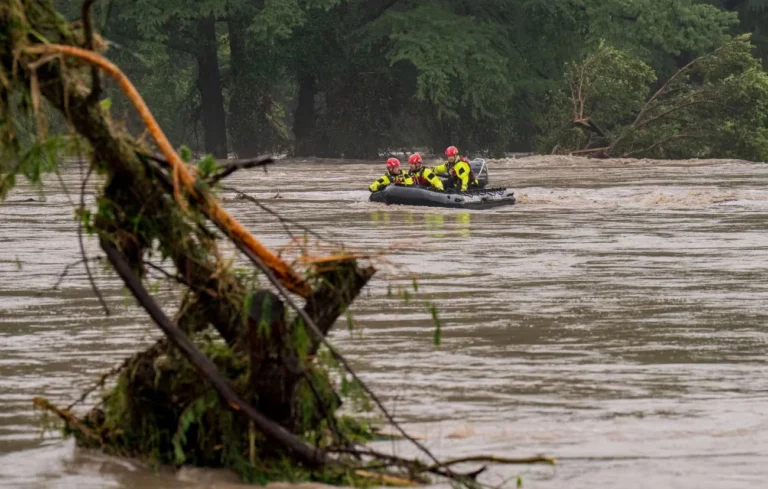Floods in the United States: A Growing and Multifaceted Threat

July 10, 2025 Hour: 11:50 am
Floods in the United States represent one of the country’s most recurrent, costly, and devastating natural threats. The recent events in southern Texas on July 4, 2025, have highlighted the growing vulnerability of American communities to extreme weather phenomena.
RELATED:
Texas Flooding is ‘Act of God,’ Says White House Press Secretary
More than 25 centimeters of rain fell in just a few hours, causing rivers to overflow, infrastructure to collapse, and loss of human life.
Far from being an isolated incident, this disaster is part of a global trend exacerbated by climate change and poor environmental management.
The Texas Case: Tragedy on the Guadalupe River
Overflow and Devastation
The early hours of July 4, 2025, will be etched in Texas’ memory as one of the most tragic in its recent history. The Guadalupe River, after receiving torrential rains, violently overflowed, sweeping away everything in its path.
Among the most heartbreaking episodes was the near-total destruction of the Christian girls’ camp “Camp Mystic,” where dozens of children between the ages of 8 and 9 went missing or lost their lives. State and federal authorities continue search and rescue operations as the death toll continues to rise.
Human and Social Impact
So far, the death toll exceeds 100 people, including at least 27 girls and counselors from Camp Mystic. The number of missing remains uncertain, and rescue teams are working tirelessly to locate those who have not yet been found.
Texas Governor, Greg Abbott has declared a state of emergency and promised that search efforts will continue until all missing persons are accounted for.
The disaster has not only left a deep mark on the affected families but has also triggered mass displacement. Thousands of residents, campers, and tourists celebrating the Fourth of July in the area were forced to evacuate urgently, leaving behind homes and belongings.
Types of Floods in the United States
Understanding the different types of inundations affecting the United States is essential to grasp the magnitude of the problem and design prevention and response strategies.
Riverine Floods
Riverine floods occur when a river’s flow exceeds its capacity and spills into adjacent areas. They are common during periods of intense and prolonged rainfall and can be worsened by deforestation or poor dam management.
A prime example is the Mississippi River, whose basin spans 31 states and has been the site of historic overflow, such as the one in 1993. That year, the Great Flood affected 75 cities and caused economic losses exceeding $20 billion, including massive damage to agriculture, transportation infrastructure, and thousands of properties.
Following the Great Flood of 1993, flood management policies in the U.S. were revised, adopting nature-based solutions such as restoring floodplains and wetlands to give rivers more space and reduce pressure on existing protection systems.
Coastal Floods or Storm Surges
Coastal floods, also known as storm surges, primarily affect coastal areas and are caused by hurricanes, tropical storms, or low-pressure systems.
Hurricane Katrina in 2005 is the most remembered case: the levee failures in New Orleans resulted in 80% of the city flooding, over 1,800 deaths, and the displacement of more than a million people.
The economic impact was estimated at over $150 billion, and the social and psychological repercussions persist to this day.
Katrina also exposed and deepened racial and socioeconomic inequalities, disproportionately affecting the most vulnerable communities.
The slow and criticized government response highlighted the need to improve emergency systems and coordination between federal, state, and local agencies.
Flash Floods
Flash floods, or torrential floods, are characterized by a rapid rise in water levels in rivers and low-lying areas, often with little to no warning.
They typically occur after heavy rainfall in areas with saturated soils, steep topography, or poor drainage. Texas, particularly the Hill Country region, is known as “Flash Flood Alley” due to the frequency and lethality of these events.
A recent example is the overflow of the Guadalupe River, which rose 8 meters in just 45 minutes, leaving over 100 dead and dozens missing. The lack of adequate early warning systems in some areas contributed to the scale of the tragedy.
Factors Aggravating Inundations in Texas
Climate Change: The Major Catalyst
Climate change is a key factor in the intensification of extreme rainfall and flooding. Meteorologists and recent studies agree that rising atmospheric temperatures, caused by human activity, allow the atmosphere to hold more moisture.
For every degree Celsius increase in temperature, the atmosphere can retain 7% more water vapor, increasing the likelihood of intense and localized precipitation.
Record temperatures in the Gulf of Mexico and higher atmospheric humidity have been cited as direct causes of the recent disaster in Texas.
Additionally, climate change is altering rainfall patterns, making events less frequent but far more intense and destructive.
Soil Conditions and Prior Drought
The region affected by the overflow had experienced a prolonged drought for over three years. The dry, hardened soil behaved almost like concrete, preventing rapid water absorption and forcing runoff across the surface.
This contributed to the rapid displacement of water into rivers and low-lying areas, increasing the destructive force of the flood.
Timing and Lack of Effective Warning Systems
The disaster occurred in the early morning hours when most people were asleep, hindering timely evacuations.
Although the National Weather Service issued flood warnings and alerts, many residents and camps did not receive the information in time, partly due to poor cell coverage and communication infrastructure failures.
This has sparked intense debate about the need to improve early warning systems and community education on disaster prevention.
Economic and Social Impact of the Floods
The July 4, 2025, floods have left a devastating toll: over 800 people rescued, hundreds of homes destroyed, and thousands displaced. Numerous roads and bridges collapsed, disrupting transportation and access to affected areas.
While it is too early to calculate the total economic impact, losses are estimated to reach several billion dollars, also affecting agriculture and local economic activity.
The social impact is equally severe. The loss of homes, disruption of daily life, and psychological trauma affect thousands of people. The most vulnerable communities, such as low-income families and ethnic minorities, are often the hardest hit and take the longest to recover.
Government Response and Criticism
President Donald Trump signed a major disaster declaration for Kerr County, allowing the release of federal funds and emergency resources.
Homeland Security Secretary Kristi Noem visited the affected areas to coordinate the federal response with state and local authorities.
However, the government’s response has faced criticism. Questions have been raised about whether warnings were sufficient and whether staffing cuts at federal agencies like the National Weather Service (NWS) and the National Oceanic and Atmospheric Administration (NOAA) under the Trump administration may have hampered forecasting and response capabilities.
Additionally, the president’s earlier intention to reduce or eliminate the Federal Emergency Management Agency (FEMA) has raised concerns about the country’s preparedness for future disasters.
The Role of Environmental Management and Prevention
Experts agree that poor environmental management, such as the lack of wetland and floodplain restoration, exacerbates flood risks.
Rapid and poorly planned urbanization reduces the land’s natural ability to absorb water, increasing community vulnerability. Investing in resilient infrastructure, restoring ecosystems, and improving early warning systems are key measures to reduce the impact of the inundations.
Collaboration between government, civil society, and the private sector is essential to design comprehensive prevention and response strategies.
Lessons Learned from Past Disasters
Hurricane Katrina is a clear example of how floods can have long-term economic and social consequences.
Beyond material damage, Katrina exposed and deepened racial and socioeconomic inequalities, disproportionately affecting the most vulnerable communities.
The experience underscores the importance of investing in prevention, climate resilience, and early warning systems to minimize the impact of future extreme events.
Conclusion
Floods in the United States, particularly the recent disaster in Texas, underscore the urgent need to strengthen risk management, invest in resilient infrastructure, and adapt public policies to the new climate reality.
Climate change will continue to increase the frequency and intensity of these events, making prevention and preparedness national priorities.
Only through coordinated action between government, civil society, and the scientific community can we reduce vulnerability and protect future generations from the devastating effects of floods.
Author: Silvana Solano
Source: TeleSUR



